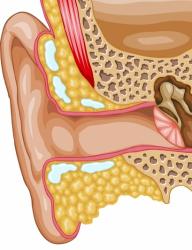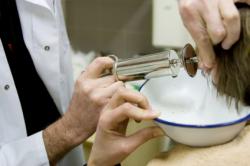(Source: HealthyHearing.com)
Regular readers of Healthy Hearing know we've covered the problem of
cerumen - commonly called ear wax - in previous editions. Why? Well, we
all have it and ear wax can cause temporary hearing problems. Also, for
persons with hearing aids, cerumen can be more common and wreak havoc on
your hearing aids.
So despite the inherent "ewww factor" associated with ear wax, let's take a look down your ear canal and provide the latest on ear care.
Cerumen isn't a sign of poor hygiene or an oversight. The production of cerumen is natural and it serves a beneficial purpose.
Cerumen is produced by glands that line the outer third of the ear canal and it isn't wax at all. It's water-soluble (it dissolves in water) and it's there to collect dust, debris, dead skin cells, hair spray and all the other gunk that would, otherwise, work its way down the ear canal to the tympanic membrane or ear drum.
So, by capturing this gunk before it collects deeper in the ear, the delicate workings of the inner ear are protected. By reaming out ear wax with a cotton swab, toothpick or some other "entrenching tool," you're actually hurting yourself. Stop cleaning your ears - at least stop reaming out your ear canal with whatever's close at hand.
The
AAO-HNSF (yes it's a mouthful) has issued new cerumen removal
guidelines for hearing care professionals; however, the guidelines
contain information that is useful for all to take home and stick inside
their medicine cabinet.
"Approximately 12 million people a year in the U.S. seek medical care for impacted or excessive cerumen," said Richard Rosenfeld, MD, MPH, Chair of the AAO-HNSF Guideline Development Task Force. "This leads to nearly 8 million cerumen removal procedures by health care professionals. Developing practical clinical guidelines for physicians to understand the harm vs. benefit profile of the intervention was essential."
You bet. And it's just as important that we all understand these new guidelines. It's a universal bodily function, but one that can cause problems, especially among special groups of people:
Serious problems occur when cerumen builds up within the ear canal and becomes impacted or compressed. This can lead to a variety of problems: • ear pain • sound distortion (your own voice sounds different)
Let's put this in bold type because it's that important: if you experience any of the symptoms listed above and you know that you have ear wax build up, do NOT try to fix the problem yourself. REPEAT: Do not try to fix the problem yourself.
To put it simple, don't stick anything down your ear canal. The chances of pushing deeper the impacted cerumen are simply too great and worse, puncturing your eardrum (ouch!). And besides, you can't even see what you're doing in there so see a professional who can handle the problem safely.
By a hearing care professional:
Take the advice of your physician or audiologist who may recommend regular visits for a safe ear cleaning.
Bottom line?
Cleaning your ears is not a do-it-yourself project like brushing your teeth. Your ears will take care of themselves under normal circumstances - no maintenance needed.
However, if you experience symptoms associated with ear wax impaction, or if you wear a hearing aid, the AAO-HNSF recommends seeing your hearing care professional every 6 - 12 months.
Dr. Peter Roland, MD, who led the team that developed these new hearing health guidelines put it this way. "The complications from cerumen impaction can be painful and ongoing, including infections and hearing loss. It is hoped that these guidelines will give clinicians the tools they need to spot an issue early and avoid serious outcomes."
Dr. Roland's point should be taken to heart, not only by hearing professionals but by individuals with cerumen problems. You know first when there's a problem with your hearing.
You're the best, strongest advocate for good hearing health. So, if ear wax is anything more unusual than "icky," make an appointment so see a hearing care professional today.
So despite the inherent "ewww factor" associated with ear wax, let's take a look down your ear canal and provide the latest on ear care.
It's Natural
 |
| Cerumen builds up in our ear canals |
Cerumen is produced by glands that line the outer third of the ear canal and it isn't wax at all. It's water-soluble (it dissolves in water) and it's there to collect dust, debris, dead skin cells, hair spray and all the other gunk that would, otherwise, work its way down the ear canal to the tympanic membrane or ear drum.
So, by capturing this gunk before it collects deeper in the ear, the delicate workings of the inner ear are protected. By reaming out ear wax with a cotton swab, toothpick or some other "entrenching tool," you're actually hurting yourself. Stop cleaning your ears - at least stop reaming out your ear canal with whatever's close at hand.
The American Academy of Otolaryngology - Head and Neck Surgery Foundation
The
AAO-HNSF (yes it's a mouthful) has issued new cerumen removal
guidelines for hearing care professionals; however, the guidelines
contain information that is useful for all to take home and stick inside
their medicine cabinet."Approximately 12 million people a year in the U.S. seek medical care for impacted or excessive cerumen," said Richard Rosenfeld, MD, MPH, Chair of the AAO-HNSF Guideline Development Task Force. "This leads to nearly 8 million cerumen removal procedures by health care professionals. Developing practical clinical guidelines for physicians to understand the harm vs. benefit profile of the intervention was essential."
You bet. And it's just as important that we all understand these new guidelines. It's a universal bodily function, but one that can cause problems, especially among special groups of people:
- 10% of children have problems with cerumen that require medical attention.
- 5% of adults have a problem serious enough for a visit to the doctor.
- 33% of the elderly have hearing issues associated with cerumen
- 33% of cognitively impaired men and women have problems.
What is so sticky about wax?
Well, the one most of us think about is cosmetic. No one wants to walk around with wax sitting in the outer ear. But a simple wash with warm water and soap will remove visible cerumen. Cosmetic problem solved, as long as the wash cloth stays outside the ear canal. If you use a wash cloth and stick to the pina - the outer ear - you'll look spiffy. And well groomed.Serious problems occur when cerumen builds up within the ear canal and becomes impacted or compressed. This can lead to a variety of problems: • ear pain • sound distortion (your own voice sounds different)
- a feeling of stuffiness or fullness in the ear canal
- persistent itching • an unpleasant odor
- ringing in the ears (tinnitus)
- discharge (an oozing substance that keeps appearing)
- persistent cough
- hearing loss
Let's put this in bold type because it's that important: if you experience any of the symptoms listed above and you know that you have ear wax build up, do NOT try to fix the problem yourself. REPEAT: Do not try to fix the problem yourself.
To put it simple, don't stick anything down your ear canal. The chances of pushing deeper the impacted cerumen are simply too great and worse, puncturing your eardrum (ouch!). And besides, you can't even see what you're doing in there so see a professional who can handle the problem safely.
The AAO-HNSF Cerumen Guidelines
So, what do the medical practitioners recommend for handling ear wax. Well, here are the new guidelines published by the AAO-HNSF:- Cerumen is beneficial. It is self-cleaning, protects the inner ear, moisturizes the ear canal and has anti-biotic properties, i.e. germs don't get through.
- People who wear hearing aids should be examined regularly for impaction that can cause feedback, limit hearing and cause further damage to the ear.
- Ear wax can cause reversible hearing loss even when 80% of the ear canal's diameter is blocked. (That's good news, so make an appointment today.)
- Removal techniques include:
- wax-dissolving agents (some o-t-c products are available for home maintenance)
 |
| Water irrigation is one cerumen removal option |
- irrigation - removing the impacted ear wax with water under mild pressure
- manual removal with special instruments
- suction, carefully controlled and monitored by the hearing professional
Take the advice of your physician or audiologist who may recommend regular visits for a safe ear cleaning.
Bottom line?
Cleaning your ears is not a do-it-yourself project like brushing your teeth. Your ears will take care of themselves under normal circumstances - no maintenance needed.
However, if you experience symptoms associated with ear wax impaction, or if you wear a hearing aid, the AAO-HNSF recommends seeing your hearing care professional every 6 - 12 months.
Dr. Peter Roland, MD, who led the team that developed these new hearing health guidelines put it this way. "The complications from cerumen impaction can be painful and ongoing, including infections and hearing loss. It is hoped that these guidelines will give clinicians the tools they need to spot an issue early and avoid serious outcomes."
Dr. Roland's point should be taken to heart, not only by hearing professionals but by individuals with cerumen problems. You know first when there's a problem with your hearing.
You're the best, strongest advocate for good hearing health. So, if ear wax is anything more unusual than "icky," make an appointment so see a hearing care professional today.
No comments:
Post a Comment